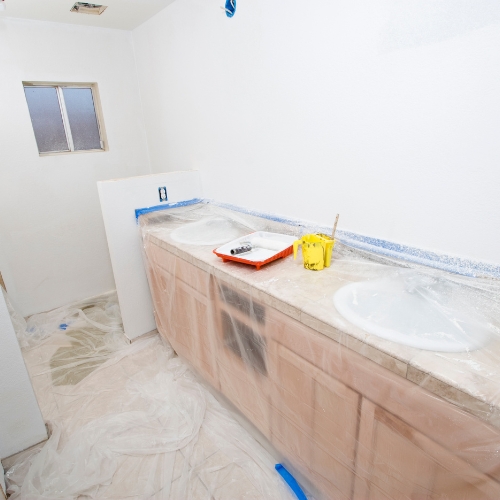When it comes to painting different parts of your home, such as walls, cabinets, and your siding, using the right primer can make a huge difference in the final finish, durability, and longevity of the paint. Primers prepare the surface, ensuring proper adhesion and enhancing color richness. This article will guide you on selecting the right primer for your specific project and discuss essential factors such as latex versus oil-based primers, brand coverage, and VOCs.
Latex vs. Oil-Based Primers
The two types of primers used in home painting projects are latex and oil-based primers.
Latex Primers
- Composition: Water-based, containing acrylic or vinyl resin.
- Application: Suitable for most indoor and outdoor applications.
- Advantages: Quick drying, low odor, flexible, and easy to clean with soap and water.
- Disadvantages: May not be suitable for surfaces that require heavy stain blocking.
Oil-Based Primers
- Composition: Solvent-based, containing alkyd or linseed oil.
- Application: Excellent for sealing surfaces with cracks and pours, blocking stains, and adhering to challenging surfaces like glossy paint or metals.
- Advantages: Superior adhesion and stain-blocking properties.
- Disadvantages: Longer drying time, strong odor, and requires mineral spirits for cleaning.
Painting companies HATE using oil-based primers!
Walls of a House
For most walls, a latex primer is often the preferred choice due to its ease of use and satisfactory performance on common wall materials such as drywall and plaster. Oil-based primers can be used if there are significant stains or if you are painting over a previous oil-based paint.
Cabinets of a Kitchen
Kitchen cabinets require a more robust primer due to constant exposure to grease and moisture. An oil-based primer is often recommended for kitchen cabinets because of its superior adhesion and stain-blocking ability.
Siding of a House
For exterior siding, both latex and oil-based primers can be used, depending on the material of the siding and the condition. Latex primers are usually preferred for wood or fiber-cement siding, while oil-based primers work well on weathered surfaces that need extensive sealing.
Coverage Differences Between Brands
Different brands offer various levels of coverage, ranging from 200 to 400 square feet per gallon. Some popular brands, such as Kilz and Zinsser, provide reliable coverage and are widely trusted by professionals. It is essential to read the product label or consult the manufacturer’s website to understand the specific coverage details of the primer you choose.
Understanding VOCs (Volatile Organic Compounds)
VOCs are chemicals found in many primers and paints that can evaporate into the air and cause health and environmental concerns. Low-VOC or no-VOC primers are becoming more popular as they reduce these risks. Look for products certified by environmental organizations or labeled as low-VOC to ensure a healthier painting experience.
Conclusion
Selecting the right primer for your home painting project involves considering the type of surface, your specific needs, and understanding the differences between latex and oil-based primers. By aligning your choice with the area you are painting, considering brand coverage, and being mindful of VOCs, you can achieve a professional, long-lasting finish. Always consult product labels and seek professional advice if unsure, as the right primer will set the foundation for a successful painting project.



Contact ALTOS Painting & Renovation
Revitalize your home or property with a stunning new paint makeover, and there’s no need to search any longer – ALTOS Painting & Renovation is your go-to local destination for top-tier painting expertise, proudly catering to homeowners and property managers throughout the enchanting regions of New Hampshire and Northern Massachusetts.
In addition to our painting services, we also offer a range of renovation services, including drywall repair, wallpaper removal, and more. Whatever your home improvement needs may be, we have the skills and expertise to get the job done right.
Services
So why wait? Contact ALTOS Painting & Renovation (603) 259-4350 or info@altosnh.com today to schedule a free consultation and estimate for your next painting or renovation project. Let us help you transform your living spaces into the home of your dreams!


